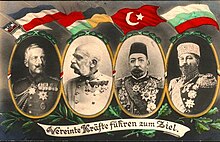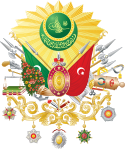Mehmed V.
| Mehmed V. | |
|---|---|
| Osmanský sultán a Chalífa etc. | |
 Německá pohlednice z roku 1917 s Mehmedem V. | |
| Doba vlády | 27. dubna 1909 – 3. července 1918 |
| Korunovace | 10. května 1909 |
| Narození | 2. listopadu 1844 Palác Topkapi, Konstantinopol |
| Úmrtí | 3. července 1918 (ve věku 73 let) Palác Yıldız, Konstantinopol |
| Předchůdce | Abdulhamid II. |
| Nástupce | Mehmed VI. |
| Manželky | I. Kam-res II. Durr-i And III. Mihr-engiz IV. Naz-perver V. Dil-firib |
| Potomci | Princ Mehmed Ziyaeddin, Princ Mehmed Necmeddin, Princ Omer Hilmi, Princezna Refia Sultana |
| Rod | Osmanská dynastie |
| Dynastie | Osmanská dynastie |
| Otec | Abdulmecid |
| Matka | Gülcemal Kadın Efendi |
| Podpis |  |
| Některá data mohou pocházet z datové položky. | |
Mehmed V. (Osmansky: محمد خامس = Meḥmed-i ẖâmis, Mehmed V Reşad nebo Reşat Mehmet) (2. listopadu 1844, Palác Topkapi, Konstantinopol – 3. července 1918, Palác Yıldız, Konstantinopol) byl mezi lety 1909 až 1918 35. a předposledním osmanským sultánem, syn sultána Abdulmecida. V mládí studoval poezii podle starého perského stylu a později byl i uznávaným básníkem. Během první světové války byl společně s Enverem Pašou hlavní postavou Ústředních mocností. Byl také obviněn pro svou úlohu v arménské, řecké a asyrské genocidě.[1]

Po jeho smrti pár měsíců před koncem první světové války nastal pád Osmanské říše. Je pohřben v historické čtvrti Eyüp v Istanbulu. Založil vyznamenání Železný půlměsíc.
Manželky, konkubíny a potomstvo
Sultán Mehmed měl pět manželek (konkubín):
- Kamures Kadınefendi
- Mihrengiz Kadınefendi
- Dürrüaden Kadınefendi
- Nazperver Kadınefendi
- Dilfirib Kadınefendi
S konkubínou Kamures měl syna:
- Şehzade Mehmed Ziyaeddin (1873 –1938), pětkrát se oženil a měl dva syny a šest dcer
S konkubínou Mihrengiz měl syna:
- Şehzade Ömer Hilmi (1888 –1935) pětkrát se oženil a měl syna a dceru
S konkubínou Dürrüaden měl syna:
S konkubínou Nazperver měl dceru:
- Refia Sultan, zemřela krátce po narození.
S konkubínou Dilfirib děti neměl, sama pak měla syna v druhém manželství.
Reference
V tomto článku byl použit překlad textu z článku Mehmed V na anglické Wikipedii.
- ↑ KIRAKOSSIAN, John S. The Armenian Genocide: The Young Turks Before the Judgment of History. [s.l.]: Sphinx Press, 1992. 323 s. (anglicky)
Externí odkazy
 Obrázky, zvuky či videa k tématu Mehmed V. na Wikimedia Commons
Obrázky, zvuky či videa k tématu Mehmed V. na Wikimedia Commons
| Předchůdce: Abdulhamid II. | Osmanský sultán 1909–1918 | Nástupce: Mehmed VI. |
Média použitá na této stránce
The Ottoman flag and Turkey Republic Flag of 1844–1935. Late Ottoman flag which was made based on the historical documents listed in the Source section. Note that a five-pointed star was rarely used in the crescent-and-star symbol before the 19th century.
Every sultan of the Ottoman Empire had his own monogram, called the tughra, which served as a royal symbol. A coat of arms in the European heraldic sense was created in the late 19th century. Hampton Court requested from the Ottoman Empire a coat of arms to be included in their collection. As the coat of arms had not been previously used in the Ottoman Empire, it was designed after this request, and the final design was adopted by Sultan Abdul Hamid II on 17 April 1882.
WW1 postcard showing Central Powers monarchs: Germany (Prussia), Austria-Hungary, Ottomans, Bulgaria
"Vereinte Kräfte führen zum Ziel" (United powers lead to the goal)
- William II of Germany
- Franz Joseph of Austria-Hungary
- Mehmed V of Ottoman Empire
- Ferdinand I of Bulgaria
35th Sultan of the Ottoman Empire and 114th caliph of Islam, Mehmed V.
Tughra of Ottoman Sultan Mehmed V




